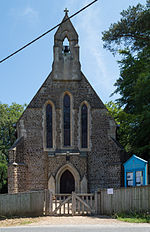Tweseldown Racecourse
1948 Summer Olympics stubsEnglish sports venue stubsLondon building and structure stubsOlympic equestrian venuesSports venues in Hampshire ... and 3 more
Summer Olympic venue stubsUse British English from February 2023Venues of the 1948 Summer Olympics

Tweseldown Racecourse southeast of Fleet, Hampshire was originally a National Hunt steeplechasing venue and the home of the equestrian dressage and eventing competitions in the 1948 Summer Olympics.Until 2012 the venue hosted Point to point racing. Lack of funds caused the owners to cease racing after the 2012 season.The interior of the course continues to be used for cross country eventing.
Excerpt from the Wikipedia article Tweseldown Racecourse (License: CC BY-SA 3.0, Authors, Images).Tweseldown Racecourse
Bourley Road, Hart Ewshot
Geographical coordinates (GPS) Address External links Nearby Places Show on map
Geographical coordinates (GPS)
| Latitude | Longitude |
|---|---|
| N 51.26 ° | E -0.8175 ° |
Address
Tweseldown Racecourse
Bourley Road
GU52 8AD Hart, Ewshot
England, United Kingdom
Open on Google Maps







